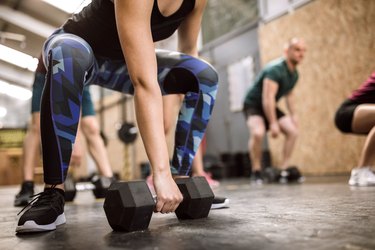
The lawn mower exercise is commonly used for scapular stabilization. Along with other movements, it may help improve shoulder function and strengthen the muscles surrounding the scapula, or shoulder blade. Your core muscles come into play as well.
Why Do Low Mowers?
Video of the Day
Shoulder injuries are extremely common, especially in athletes. About one-third of them occur during sports, according to an August 2019 report in the BMJ Open Sport and Exercise Medicine. However, everyday activities like gardening and painting the walls may cause injuries to the shoulders too.
Video of the Day
Some injuries are characterized by shoulder instability, causing pain when raising the arm. Others affect the rotator cuff muscles, leading to impaired shoulder function. As the American Academy of Orthopaedic Surgeons notes, keeping the shoulder muscles strong through exercise may help prevent injuries in the first place.
Read more: 7 Easy Moves for Strong 'n Sexy Shoulders
The lawn mower is commonly used as a shoulder-strengthening exercise. This multi-joint dynamic movement engages the lower trapezius, serratus anterior and other back muscles that help stabilize the shoulder joint. It also works your core and lower body muscles to some extent, points out the National Academy of Sports Medicine (NASM).
A May 2012 review published in Rehabilitation Research and Practice states that the impairment of one or more kinetic chain links may increase injury risk. The kinetic chain describes the joints and muscles that work together during movement. The scapula, for example, assists with the movement of the shoulder, forming the socket where the upper arm bone sits.
The lawn mower exercise activates the serratus anterior, a muscle that moves and stabilizes the scapula when you raise your arm. This movement assists with scapular external rotation, which may help improve shoulder function in the long run.
Lawn Mower Exercise Instructions
Lawn mowers can be performed with dumbbells, resistance bands, cable machines or your own body weight. The basic movement is the same, regardless of the resistance used. The Rehabilitation Research and Practice review recommends the next steps:
- Stand with your legs slightly wider than shoulder width apart. Place your left hand on your left hip.
- Bring your hips back by bending at the waist. Bring your left leg forward.
- Extend your right arm so that your hand nearly touches your left foot.
- Move into an upright position and rotate your torso along with your arms to the right, transferring your weight onto the back foot. Imagine you're starting a lawn mower.
- Squeeze your shoulder blades together and down as you rotate your torso.
- Repeat on the other side.
Another option is to attach an elastic band to a stable object on the floor or step on it with your left foot. Perform the exercise as described above. Keep your left arm relaxed at your side or place the hand on your hip or thigh — whatever is easier for you.
Likewise, you can perform dumbbell lawn mowers. Simply hold a light dumbbell in your right hand throughout the movement and then repeat on the other side. However, it's safer to skip the weights during your lawnmower workout if you have a shoulder injury.
Lawn Mowers and Your Back
The lawn mower engages the trapezius and serratus anterior, which are superficial muscles of the back, but it may improve shoulder function as well. It's commonly used along with the quadruped shoulder flexion and other movements for scapular stabilization.
Read more: The Best Exercises for Every Major Muscle
All in all, this movement can benefit your back. It's unlikely to help you build muscle, but it may improve shoulder strength and stability. Another advantage is that it may enhance coordination between the core and lower extremity muscles, states the NASM.
If you're trying to build a strong back, try inverted rows, seated rows, pull-ups and other exercises that target the major back muscles. Chin-ups, pull-ups and bent-over rows, for example, produce the greatest activation of the latissimus dorsi, according to a small study published by the American Council on Exercise in April 2018.
As the researchers note, bent-over rows engage three of the five major back muscles, including the infraspinatus, middle trapezius and erector spinae, to a greater extent than other exercises. Therefore, they should be an integral part of your back workout routine.
- BMJ Open Sport and Exercise Medicine: "Sports-Related Acute Shoulder Injuries in an Urban Population"
- American Academy of Orthopaedic Surgeons: "Shoulder Pain and Common Shoulder Problems"
- National Academy of Sports Medicine: "Shoulder Function: Enhancing Scapular Stabilization"
- Rehabilitation Research and Practice: "Kinetic Chain Rehabilitation: A Theoretical Framework"
- American Council on Exercise: "What Is the Kinetic Chain?"
- American Academy of Orthopaedic Surgeons: "Scapular (Shoulder Blade) Disorders"
- Cornell University: "Lawn Mower"
- American Council on Exercise: "What Is the Best Back Exercise?"